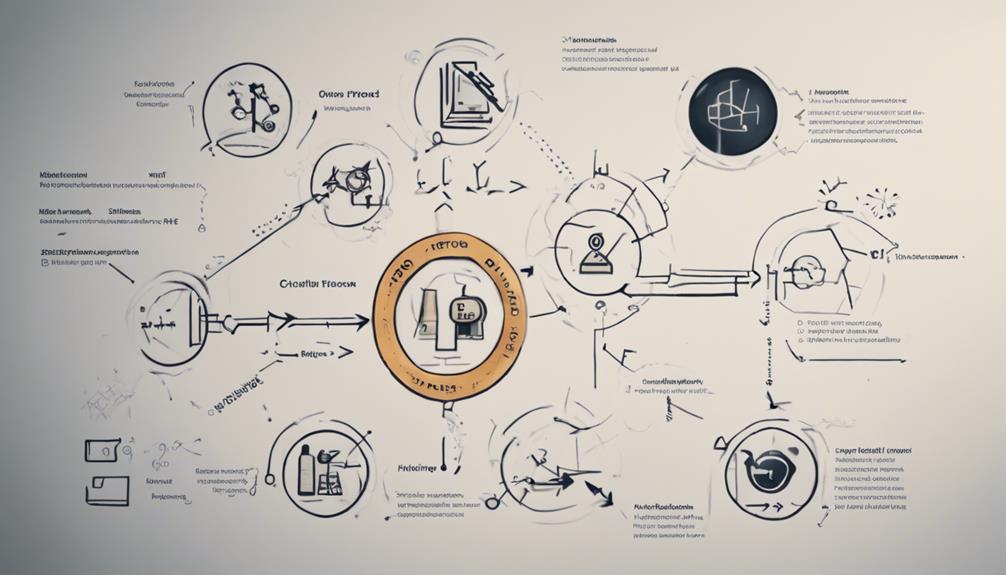When I started my first workflow automation, I focused on choosing the right tool by considering ease of use, scalability, and integration options. I identified repetitive, time-consuming tasks ripe for automation. I mapped out current processes to visualize steps and pinpoint inefficiencies. Setting clear workflow goals was vital—defining specific, measurable objectives and key performance indicators. Implementing the automation involved selecting tools like Zapier or Microsoft Power Automate, followed by rigorous testing and continuous monitoring to guarantee alignment with goals. Finally, scaling efforts to handle increased complexity was essential for long-term success. Learn the detailed steps to master workflow automation.
Key Takeaways
- Identify repetitive, time-consuming tasks with clear steps and predictable outcomes for automation.
- Map current processes to visualize steps, dependencies, and inefficiencies to optimize workflows.
- Define clear objectives and key metrics for measuring the impact of automation.
- Choose tools with intuitive design, integration capabilities, and scalability for effective automation.
- Test automated workflows rigorously and continuously refine based on feedback and performance metrics.
Choosing the Right Tool
When selecting the right workflow automation tool, you should consider factors such as ease of use, available features, scalability, and integration options.
I always start by evaluating how well the workflow automation software aligns with my business processes and tasks. Look for software tools like monday.com, known for its centralized workflow management and robust collaboration features. These tools not only streamline operations but also offer critical integration capabilities that are essential for seamless business processes.
Guarantee the platform provides templates, task assignments, progress tracking, notifications, and visual representations of workflows. Such features reduce errors, enhance productivity, and save valuable time and resources. Opting for customizable and mobile-accessible options makes managing tasks on the go effortless and efficient.
Identifying Tasks to Automate
Identifying tasks to automate starts by pinpointing repetitive activities with clear steps and predictable outcomes. I look for tasks that are time-consuming and error-prone, often requiring manual intervention. Workflow automation shines when involving multiple team members, communication, or data transfer. Tasks with well-defined inputs, outputs, and decision points are prime candidates for automation, enhancing efficiency and accuracy. Here's a useful table to paint a clearer picture:
| Task Type | Characteristics | Automation Benefits |
|---|---|---|
| Data Entry | Repetitive, predictable, manual | Time-saving, reduced errors |
| Report Generation | Regular, structured, involves data transfer | Increased efficiency, accuracy |
| Email Notifications | Routine, communication-heavy | Consistency, time-saving |
| Invoice Processing | Well-defined steps, multiple approvals | Faster workflow, fewer errors |
Mapping Current Processes

To start mapping current processes, I first identify the key steps involved in each workflow.
Next, I analyze the dependencies between tasks to understand how they interact.
Identify Key Process Steps
Mapping current processes involves creating a thorough visual representation of each step in the workflow to highlight inefficiencies and redundancies. By conducting detailed process mapping, I can identify the sequence of tasks and decision points essential for effective workflow automation.
This step in the workflow automation guide allows me to pinpoint bottlenecks and inefficiencies, providing a clear overview of task execution. Understanding these elements sets a baseline for improvement. I'll meticulously document each process step, ensuring no detail is overlooked.
This extensive visualization not only aids in spotting issues but also lays the groundwork for seamless automation. In doing so, I'm better equipped to innovate and optimize workflows, driving efficiency and removing redundancies.
Analyze Task Dependencies
By dissecting the relationships between each task, I can pinpoint the precise sequence and dependencies crucial for an optimized workflow.
Understanding current processes is key to identifying task dependencies and enhancing efficiency through automation. To achieve this, I map out each step, revealing how tasks are interconnected and the order they must follow.
This detailed analysis helps in:
- Uncovering bottlenecks that slow down the workflow.
- Identifying redundancies that waste resources.
- Streamlining task coordination for smoother handovers.
- Enhancing overall efficiency by targeting critical dependencies.
Mapping current processes provides a clear visualization of task dependencies, enabling me to optimize workflows and improve efficiency through strategic automation.
This foundational step ensures that all subsequent automation efforts are well-coordinated and effective.
Document Workflow Variations
I meticulously document each step of the workflow, capturing variations in approval processes, version control, and access permissions to pinpoint inefficiencies.
Through detailed workflow mapping, I visualize how documents move from creation to storage and retrieval. By documenting these variations, I can identify bottlenecks and streamline processes more effectively.
This analysis is essential for designing automation solutions that enhance efficiency and reduce errors. Understanding document workflows in granular detail allows me to propose innovative changes that foster productivity.
Setting Workflow Goals
When setting workflow goals, I start by defining clear objectives such as reducing processing time or improving task completion rates.
I identify key metrics like cost savings and error reduction to measure success accurately.
Then, I prioritize tasks based on their importance to guarantee the most impactful improvements.
Define Clear Objectives
Establishing clear objectives is crucial for pinpointing the purpose and expected outcomes of your workflow automation. When setting workflow objectives, I guarantee they're specific, measurable, achievable, relevant, and time-bound (SMART). This approach helps me select the right workflow automation tools, design efficient processes, and measure automation success.
By defining clear goals, I can:
- Identify the exact tasks to be automated.
- Predict the expected results of the automation process.
- Establish key performance indicators (KPIs) to monitor progress.
- Align team members and enhance collaboration for better efficiency.
Clear objectives guide the entire automation process, keeping it focused and goal-oriented. This structured approach ensures that every step contributes to achieving the desired automation success.
Identify Key Metrics
With clear objectives in place, the next step is to identify key metrics that will measure the success and efficiency of the workflow automation. By defining measurable outcomes, I can align my automated workflows with overarching business processes. For instance, leveraging sophisticated software and management tools, I aim to reduce errors and enhance customer satisfaction.
Here's a table to outline some important metrics:
| Metric | Goal |
|---|---|
| Processing Time | Reduce by 50% |
| Task Completion Rates | Increase by 20% |
| Error Reduction | Decrease by 30% |
| Cost Savings | Achieve 15% reduction |
Tracking these metrics allows me to quantify the impact of automation, ensuring increased productivity, improved accuracy, and better collaboration among team members.
Prioritize Task Importance
To prioritize task importance, I focus on identifying the most critical and high-impact tasks that will benefit the most from automation.
Setting clear workflow goals guarantees we maximize productivity impact and streamline complex processes. Here's my approach:
- Assess Task Complexity: Determine which tasks are repetitive and straightforward versus those that require more nuanced automation.
- Evaluate Productivity Impact: Identify tasks that, when automated, will save the most time and resources.
- Define Expected Outcomes: Clearly outline what success looks like regarding efficiency gains and error reduction.
- Identify Benefits of Automation: Highlight how automation will improve workflow, from reducing processing time to enhancing task accuracy.
Designing Your Workflow

In designing your workflow, start by visually mapping out each step to clearly understand the flow and interconnections of your process. Use tools like flowcharts for effective process visualization. Identify key tasks, decision points, and dependencies. Consider potential automation triggers to streamline operations and enhance task management. A well-structured workflow design is essential for workflow optimization and sets the stage for seamless workflow implementation.
Here's an example to visualize:
| Step | Description |
|---|---|
| Start | Initiate process |
| Task 1 | Identify key tasks |
| Decision Point | Evaluate conditions |
| Task 2 | Execute on decision |
| End | Process completion |
Implementing Automation
Implementing automation starts with selecting the right tools that align with your specific workflow requirements and seamlessly integrate into your existing systems. By employing workflow automation tools like Zapier, Microsoft Power Automate, or Kissflow, I can reduce manual effort and streamline processes efficiently.
However, I need to be mindful of potential challenges, such as employee resistance and integration issues.
Key features to look for in workflow management software include:
- Intuitive workflow designers for ease of use.
- Integration capabilities to guarantee seamless data flow.
- Cloud-based technology for accessibility and scalability.
- Role-based access control to uphold security and compliance.
Testing and Refining

After selecting the appropriate tools, I must rigorously test the automated workflows to guarantee they operate as intended. Testing is vital to confirm the processes function correctly and efficiently.
I gather user feedback and analyze performance metrics during this phase to identify any issues or bottlenecks. Continuous testing allows me to refine the workflow automation, making necessary adjustments for optimization.
Refining based on test results and feedback leads to significant improvements in productivity, accuracy, and overall efficiency. By focusing on these aspects, I can ensure the automated workflows meet the desired objectives and perform at their best.
This detailed approach to testing and refining is essential for achieving innovation in workflow automation.
Monitoring Performance
To guarantee the efficiency and reliability of my automated workflows, I continuously monitor performance by tracking key metrics such as task completion rates, response times, and error frequencies. I rely on advanced analytics tools to generate detailed reports that highlight workflow efficiency and pinpoint areas needing improvement.
Additionally, I set up alerts and notifications to proactively address any issues that could hinder performance. Regularly reviewing performance data confirms that my workflows remain aligned with organizational goals.
Key actions in monitoring performance include:
- Tracking Key Metrics: Task completion rates, response times, error frequencies.
- Using Analytics Tools: Generating and analyzing performance reports.
- Setting Alerts and Notifications: Immediate action on bottlenecks.
- Implementing Feedback Loops: Gathering insights for continuous improvement.
Scaling Automation Efforts

Effectively scaling automation efforts demands meticulous planning to guarantee that the expanded processes can seamlessly handle increased workloads and complexity. When I scale automation, I need to evaluate the impact of increased data volume, additional users, and integration requirements. Scalable automation ensures that as my organization grows, we can maintain efficiency and reduce manual labor costs. Here's a detailed look at the key considerations:
| Consideration | Details |
|---|---|
| Increased Data Volume | Confirm systems handle larger datasets |
| Additional Users | Support more concurrent users |
| Integration | Seamlessly integrate with existing systems |
| Complexity Management | Simplify new layers of complexity |
| Resource Utilization | Optimize use of resources |
Planning for scalable automation allows my organization to enhance productivity, streamline operations, and utilize resources more effectively.
Frequently Asked Questions
How Do I Start Workflow Automation?
To start workflow automation, I first identify repetitive tasks, then focus on tool selection. I map workflows to understand processes and plan for scalability. I address integration challenges and prioritize user training to maximize automation benefits.
What Are the 5 Steps of Workflow?
"You can't manage what you don't measure. The 5 steps of workflow are: task identification, workflow mapping, process analysis, assigning responsibilities, and setting deadlines. Use automation software and workflow documentation for efficiency improvement."
How to Begin Process Automation?
To begin process automation, I first identify manual processes. Then, I select software tools that offer automation benefits like time savings, error reduction, and task delegation. Finally, I map out workflows to optimize and streamline operations.
What Is the First Step to Approaching Automation?
How do you kickstart automation? I identify goals, assess needs, and define objectives. Next, I analyze processes, evaluate tools, and gather requirements. This approach guarantees tailored solutions, minimizing errors, and maximizing efficiency for innovative, process-driven results.
Conclusion
In wrapping up, diving into workflow automation is like setting sail on a well-charted course. By carefully choosing the right tool, pinpointing tasks to automate, and mapping out current processes, I've built a solid foundation.
Setting clear goals, designing workflows, and implementing automation guarantees smooth sailing. Testing, refining, and monitoring performance are the navigational aids that keep me on track.
As I scale my efforts, I'm confident that my automation journey will lead to increased efficiency and productivity.





